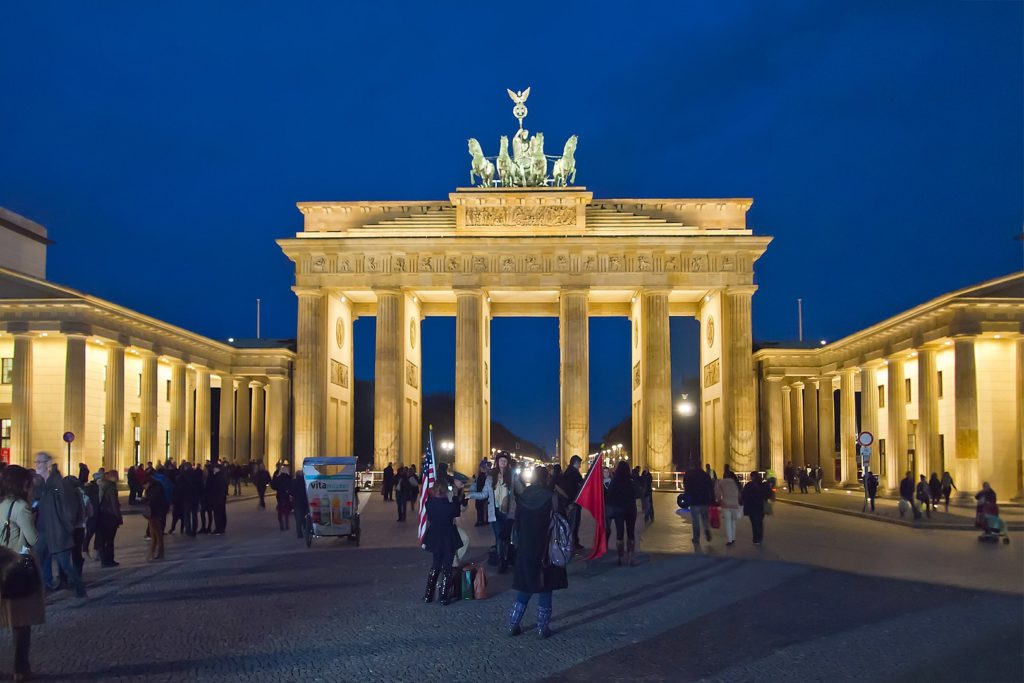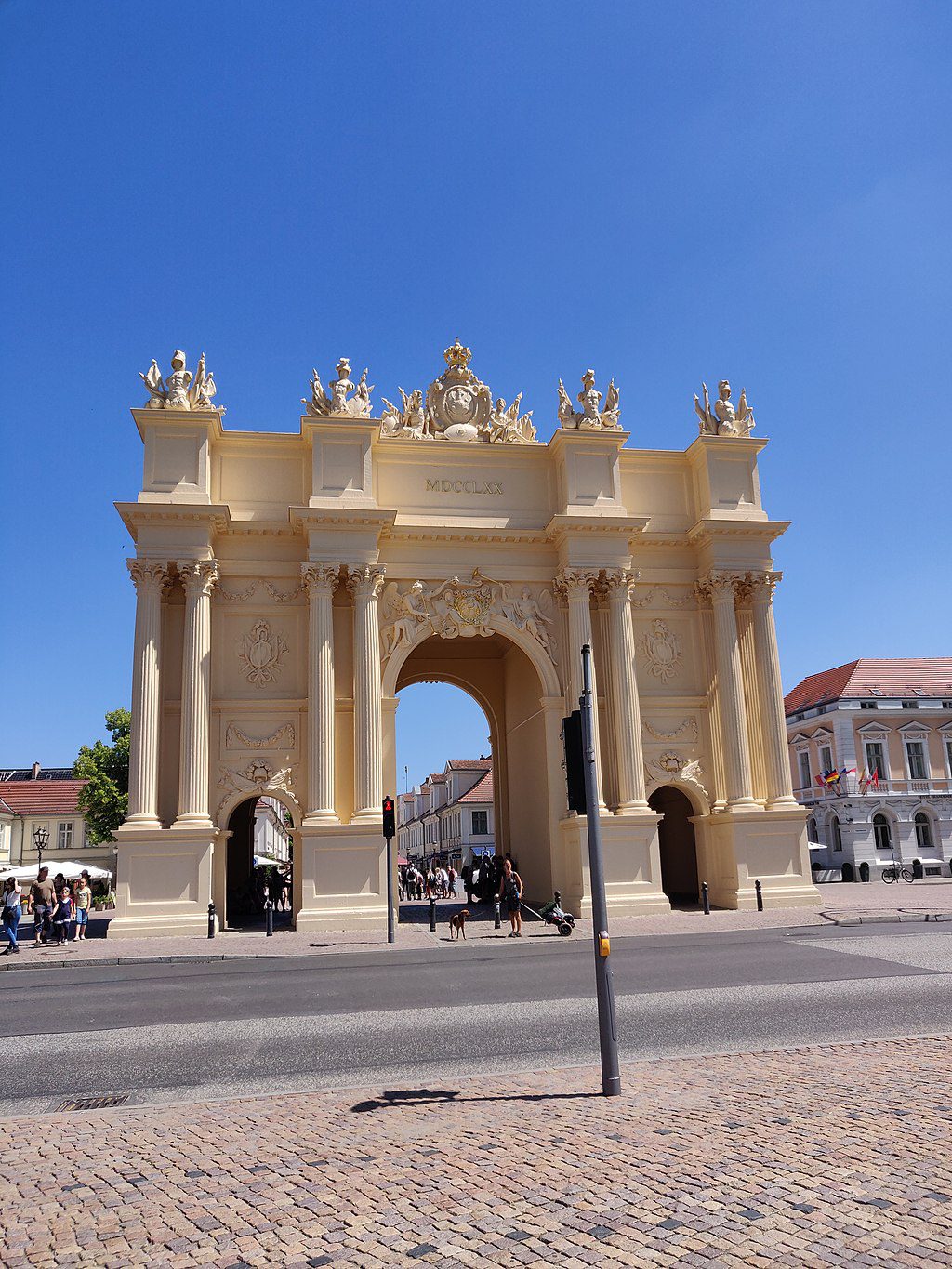
By Mark König – Wikimedia
Top 15 Facts about the Brandenburg Gate
*Originally published by Lilian on November 2020 and Updated by Vanessa R on May 2023
If you have been Berlin, then you must have been to the Brandenburg gate. Here is a little back story to this magnificent landmark.
The Brandenburg Gate is an 18th-century neoclassical monument in Berlin.
This gate was commissioned by the Prussian king Frederick William II. This was after the temporary restoration of order during the Batavian Revolution.
It is one of the most famous landmarks in Berlin and Germany at large.
This gate was built on the site of the former city gate that used to connect Berlin and Brandenburg a der Havel.
The gate is located in the western part of the city centre of Berlin within Mitte.
It acted as an entryway to the boulevard of linden trees that led to the royal City Palace of the Prussian monarchs.
Throughout history, this monument has been the site of major historical events. There are more facts about this gate that will intrigue you.
Here are the top 15 facts about Brandenburg Gate.
1. It was commissioned by Friedrich Wilhelm II in 1791

By Yair Haklai – Wikimedia
King Friedrich Wilhelm II ordered the construction of this gate which was officially opened in August 6th 1791.
It was built to mark the end of the boulevard Unter den linden and not for political reasons as is commonly believed.
Before the construction of this gate, Berlin was a small walled town with several gates.
But after the reign of King Friedrich Wilhelm II, he built this gate in the place of guardhouses at the gate.
It was known as the peace gate.
The gate was designed by Carl Gotthard Langhans, the Court Superintendent of Buildings.
It is made up of twelve Doric columns, six to each side, forming five passageways.
2. The Brandenburg Gate is one of the eighteen original gates of the Berliner Zoll und Akzisemauer
This Gate is one of the eighteen original gates of the Berlin customs and excise wall. It used to surround Berlin and is the only gate standing tall.
Berlin was a small walled city in the 18th century and it was within a star fort with several named gates.
The gates were: Spandauer Tor, St. Georgen Tor, Stralower Tor, Cöpenicker Tor, Neues Tor, and Leipziger Tor.
These gates were of no defence function but served as routes for imposing a levy of taxes on imported and exported goods.
3. The gate also acted as a party symbol

By War Office official photographer – Wikimedia
Although the initial purpose of this gate was not political, it changed in the 20th century.
This happened when the Nazis ascended to power, they used the gate as a party symbol.
The gate was almost destroyed during World War II. It is one of the damaged structures that is still standing in the Pariser Platz ruins.
There were holes in the columns from bullets and nearby explosions. Only one horse’s head from the original quadriga survived.
The horse’s head is kept in the collection of the Märkisches Museum.
At the end of the war, the governments of East Berlin and West Berlin restored it in a joint effort.
4. Vehicles no longer go through the gate
Just after the construction of the gate, both vehicles and pedestrians were allowed to travel freely through the gate until the day after construction when the Berlin Wall was fenced with barbed wire.
At that time, only the royal family was allowed to pass through the central archway, as well as members of the Pfuel family.
This honour was granted to the Pfuel family in gratitude to Ernst von Pfuel, who had overseen the return of the Quadriga to the top of the gate.
Ambassador coaches were also allowed to use the central archway on the single occasion of their presenting the letters of credence to the council.
5. The Brandenburg gate symbolizes a united Berlin

By Yair Haklai – Wikimedia
This gate was opened several weeks later after the wall of Berlin fell in 1986.
After World War II, a Soviet flag was placed on top of the gate but was removed in 1957 and replaced with an East German flag.
That flag was removed after the reunification of Germany in 1990 and the pole removed.
It was opened by East German Premier Hans Modrow and West German Chancellor Helmut Kohl.
More than 100,000 people attended the opening celebration.
6. Several celebrations have been held at Brandenburg Gate
Brandenburg Gate was the main venue for the 20th-anniversary celebrations of the fall of the Berlin Wall otherwise known as Festival of Freedom in 2009.
The peak of the celebration was when 1000 colourfully designed domino tiles were lined along the former wall through the city centre.
For the best experience at the Brandenburg Gate, visiting during the New Year’s event is exciting.
There is live music, fireworks, and merry-making. The gate is, however, open all year round.
7. The gate was closed for almost 3 decades

By Olga Ernst – Wikimedia
The Brandenburg Gate was closed for almost 30 years. This was after the Berlin Wall that divided East Berlin and West Berlin was completed in 1961.
The gate was re-opened in 1989 and later renovated from the year 2000 to 2002, with private funds amounting to 6 million euros.
During previous renovation works, the quadriga was removed from the gate as part of renovation work carried out by the East German authorities.
It was once again opened on 3 October 2002 following an extensive renovation, to celebrate the 12th anniversary of German reunification.
8. Napoleon was the first to use the Brandenburg Gate for a triumphal procession
This Gate has played different political roles in German’s history.
After the 1806 Prussian defeat at the Battle of Jena-Auerstedt, Napoleon became the first to use the Brandenburg Gate for a triumphal procession.
He took its Quadriga to Paris. It was later returned after he was defeated in 1814.
The Quadriga was then redesigned by Karl Friedrich Schinkel as a Prussian triumphal arch.
This statue depicts the goddess of victory on a chariot pulled by four horses.
9. The gate symbolized freedom

By Pedelecs – Wikimedia
After the Revolutions of 1989, the Berlin wall was demolished.
The gate then symbolized freedom and the desire to unify the city of Berlin.
Several people gathered at the wall to celebrate its fall in 1989. Later in December that same year, the Brandenburg Gate border crossing was reopened.
10. Two American presidents have been to Brandenburg

Official White House Photo by Pete Souza
The most recent visit by an American president to the gate was on 19 June 2013, when President Barack Obama gave a speech at the Gate about nuclear arms reduction.
Almost 26 years earlier on 12 June 1987, the then U.S. President Ronald Reagan spoke to the West Berlin populace at the Brandenburg Gate.
He demanded that the wall should be razed down. During his visit, the wall was covered in a red flag to prevent him from seeing the Eastern side.
11. The gate was initially used to collect taxes

Cezary p at Polish Wikipedia, CC BY-SA 3.0, via Wikimedia Commons
A new outer wall known as the “Berlin Customs Wall” was built as the city expanded quickly during this period of prosperity and growth in the 18th century. 18 gates, including the Brandenburg Gate, made up this wall, which was constructed between 1737 and 1860. In reality, the wall and gates served only to collect taxes from visitors to the city rather than to provide true protection.
12. It was originally called the “Friedenstor”
Frederick Willem II of Prussia ordered the construction of a new Brandenburg Gate, and Carl Gotthard Langhans, the court director of buildings, was tasked with serving as the project’s principal architect. The monument’s building was started in 1788 and finished in 1791. The Brandenburg Gate was constructed in order to symbolise the city’s tranquillity. The “Friedenstor” or “the Peace Gate” were its original names because of this.
13. There’s another Brandenburg Gate

Kurt Kaiser, CC0, via Wikimedia Commons
The Brandenburg Gate is not to be mistaken with the Brandenburg Gate in Potsdam, a city next to Berlin, which is located on the Luisenplatz. In 1770–1771, two decades earlier, this monument was constructed. A monumental arch, the Potsdam Brandenburg Gate resembles the Arc de Triomphe in Paris or the Arch of Constantine in Rome.
14. The Quadriga was added on top of the Brandenburg Gate in the year 1793
Because so many classical structures, including monuments, were built during this time, it is thought that the monument fits the architectural style of Berlin at the time. The Quadriga, which shows Victoria, the Roman goddess of victory, riding a chariot pulled by four horses, is one of the Brandenburg Gate’s most notable features. This magnificent statue was created by Johann Gottfried Schadow (1764–1850), one of the most well-known Prussian sculptors of the time.
15. It was once a symbol of evil
When the Nazis came to power, Nazi Propaganda Minister Joseph Goebbels was eager to utilise the Brandenburg Gate as a national emblem. In that sense, it changed from being a representation of freedom to its complete opposite.
Planning a trip to Paris ? Get ready !
These are Amazon’s best-selling travel products that you may need for coming to Paris.
Bookstore
- The best travel book : Rick Steves – Paris 2023 – Learn more here
- Fodor’s Paris 2024 – Learn more here
Travel Gear
- Venture Pal Lightweight Backpack – Learn more here
- Samsonite Winfield 2 28″ Luggage – Learn more here
- Swig Savvy’s Stainless Steel Insulated Water Bottle – Learn more here
Check Amazon’s best-seller list for the most popular travel accessories. We sometimes read this list just to find out what new travel products people are buying.










